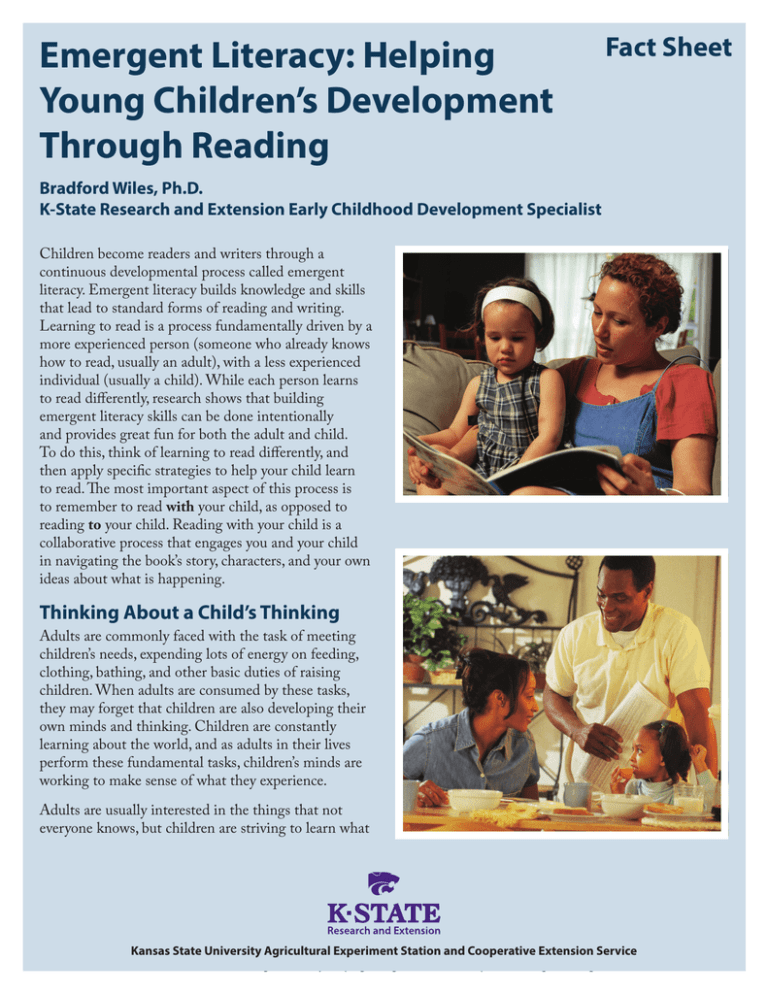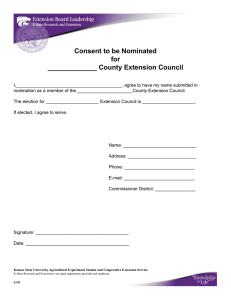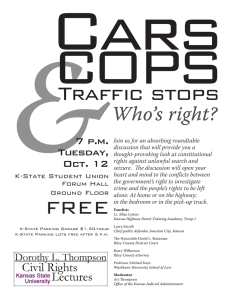
Emergent Literacy: Helping
Young Children’s Development
Through Reading
Fact Sheet
Bradford Wiles, Ph.D.
K-State Research and Extension Early Childhood Development Specialist
Children become readers and writers through a
continuous developmental process called emergent
literacy. Emergent literacy builds knowledge and skills
that lead to standard forms of reading and writing.
Learning to read is a process fundamentally driven by a
more experienced person (someone who already knows
how to read, usually an adult), with a less experienced
individual (usually a child). While each person learns
to read differently, research shows that building
emergent literacy skills can be done intentionally
and provides great fun for both the adult and child.
To do this, think of learning to read differently, and
then apply specific strategies to help your child learn
to read. The most important aspect of this process is
to remember to read with your child, as opposed to
reading to your child. Reading with your child is a
collaborative process that engages you and your child
in navigating the book’s story, characters, and your own
ideas about what is happening.
Thinking About a Child’s Thinking
Adults are commonly faced with the task of meeting
children’s needs, expending lots of energy on feeding,
clothing, bathing, and other basic duties of raising
children. When adults are consumed by these tasks,
they may forget that children are also developing their
own minds and thinking. Children are constantly
learning about the world, and as adults in their lives
perform these fundamental tasks, children’s minds are
working to make sense of what they experience.
Adults are usually interested in the things that not
everyone knows, but children are striving to learn what
Kansas State University Agricultural Experiment Station and Cooperative Extension Service
K-State Research and Extension — Emergent Literacy: Helping Young Children’s Development Through Reading, Fact Sheet
1
everyone already knows. The first step in how to make
learning to read more fun, engaging, and productive is
to think about your child’s thinking. This approach to
child development is called being “mind-minded.” It
sets the stage for building the child’s reading through a
process called scaffolding.
Mindfulness
Mindfulness is best conceptualized as a process
of being able to draw new distinctions, examine
information from new perspectives, and being aware
of the time of day, location, and other factors affecting
an activity. It is a way of thinking about things not
as they are, but as they could be, and recognizes the
potential for many different outcomes. Essentially,
mindfulness is an active and intentional way of being
in the moment. This framework encourages you
to deliberately think about what is happening and
respond with practices to extend thinking and learning.
Mind-mindedness
Mind-mindedness involves treating your child as an
individual with a mind, as opposed to just an individual
with needs (for example, food, clothing, shelter).
Adults know they need to meet children’s needs. But
they can do so in a mind-minded fashion by thinking
about a child’s thinking. This helps extend learning
in everyday need-meeting interactions. For example,
when cooking, an adult can think about what a child
might be thinking about the way food is prepared, and
use a technique known as scaffolding to build a child’s
mental capacity, while still meeting basic needs.
Mind-mindedness emphasizes listening to what
the child says to better anticipate and intentionally
respond. For example, if you are making soup, you can
talk about the vegetables you’re cutting up and why you
do that. You can even let your child taste some of those
that can be eaten raw.
Scaffolding
In the construction world, scaffolds are intentional,
temporary, and flexible structures used in building.
In a similar way, mental and language scaffolding is
built to match a child’s development. The building,
constructing, and positioning of resources to create
scaffolds involves active processes, which allow the
building to be built with supporting structures that
eventually are no longer necessary. There are many ways
to think about scaffolding, but here are six approaches
2
that have proven effective in building cognitive and
social-emotional skills in children.
Questioning
Asking questions in a mindful and mind-minded
manner is one of the easiest and most productive ways
for adults to interact with children. Begin by assessing
what the child already knows about the current topic.
Ask questions that help you assess the child’s thinking.
For example, “Do you know what color that is?” or,
“Do you know what this is called?” Answers to these
questions help adults assess the child’s understanding
of the world. Often these questions can be answered
with either a “yes” or “no,” or a single word response.
While the aim of scaffolding is to provide assistance to
children in learning, you must first know where they
are to then apply developmentally appropriate practices
to help them learn. If a child does not know the color
red, asking him to hand you the red pencil would be a
useless request, as he could not possibly comply.
Assistance questions help you assist a child. These are
the questions that an adult asks that make a child really
K-State Research and Extension — Emergent Literacy: Helping Young Children’s Development Through Reading, Fact Sheet
think about something, and therefore helps them in
thinking about what they are experiencing. Assistance
questions are always open-ended, which requires the
child to think about something she might not have ever
considered before. One of the most important questions
to ask a child, especially in response to a questions is,
“Well what do you think the answer is?”
Assistance questions are who, what, why, and how
questions. For example, “What do you think is going to
happen next in this story?” or “What do you think that
character is thinking about?” Such questions provide
opportunities for the child to extend his thinking
and learning and also help him think about another’s
thoughts, beliefs, desires, and intentions. They establish
the foundation for understanding another perspective,
which is crucial in social-emotional development. This
skill helps children get along better with peers, siblings,
and adults, and has been shown to be beneficial in
other ways, such as academic achievement.
Explaining and Instructing
Just as adults can tire of being peppered with questions,
children can easily tire of being quizzed. Additionally,
while questioning is a useful strategy, providing
explanation or instruction can also encourage a child’s
development through contributing new information
to build upon. Sometimes children (and adults) need
just a single piece of information that helps them make
the leap to full understanding. At other times, children
just want to know more. Adults should assess what a
child knows through questioning, and then follow up
with some mix of scaffolding strategies. Explanation
and instruction scaffolding strategies usually serve as
the default for adults, who may be inclined to answer
a question or explain what is happening. But you can
easily over-rely on explaining as a strategy, so use it in
moderation.
Modeling
Adults are constantly modeling human behavior and
interaction for children. Remember, children are
constantly trying to learn what almost every adult
already knows. Learning through observation is one
of the easiest strategies for children, as it requires
very little effort, and produces benefits for children in
figuring out how the social and physical world works.
Adults serve as models for how people interact, how
to behave in a particular situation, and how to treat
others. When interacting with children, adults can be
mindful of the effect their modeling has and model
the desired behavior for a child. For example, when
reading with a child, sounding out words models for
children how to look at the print and determine how
a word sounds. Being mindful and mind-minded in
these instances helps you remember to demonstrate
positive ways of navigating the world.
There is also a richer type of modeling — imitating
what you see. For example, you can flap your arms
to mimic a bird’s flight. When you physically model
things you see in books, you maintain and enhance
the child’s interest in your behavior. Additionally, you
can teach children about the world through modeling
with your body and voice. Using the tone, inflection,
and pitch of your voices to enhance your portrayal of
the world raises the child’s interest, which is always
effective when teaching a child.
Feedback
Feedback alone can lead a child to considerable
improvement. Providing feedback can be the single
most effective means of assistance. Feedback should be
relative to a standard because providing performance
information is not feedback unless it is relative to
this standard. For example, commenting on a child’s
performance by saying, “good job” is not actually
feedback. Saying, “You did a good job. You used to
struggle with that” or “That’s better than you did last
time” are different. This way, the child learns about
performing well relative to previous experience or an
established standard. The difference between, “You did
a good job” and “You did a good job, because” cannot
be understated. When you are mindful of the child’s
need to know why, when you provide the because, the
importance of doing so becomes clear.
Maintaining Focus
When reading with a child, maintaining the child’s
focus can be difficult. Children are still developing the
skills necessary to maintain their attention and follow
the story of a book. You can manage these distractions
in multiple ways, including using your authority as an
adult to force compliance. “Because I said so” is one of
the most common reasons adults give children who
ask why they need to do something. Adults should
only use such commands when a child’s safety is at
stake. When reading, offering choices such as finishing
a page and then doing something else, stopping now,
or skipping ahead, can give a child options. This helps
build a sense of agency, which is the ability to act on
your own. Throughout this process, being mindful and
K-State Research and Extension — Emergent Literacy: Helping Young Children’s Development Through Reading, Fact Sheet
3
mind-minded helps you strengthen the child’s ability
to maintain focus. There is always a delicate balance
between following the child’s line of thinking, which
often leaves the context of the book, and maintaining
focus. Try to follow the child’s thinking when he
appears to be off-track, because some of the most fun,
hilarious, insightful, and heartwarming stories are told
when you let your child tell you what he is thinking.
Structuring
The act of structuring an activity, such as reading a
book, provides a child with much-needed information
about what to expect. For example, when reading a
book with a child, you can structure the activity by
saying you are going to read and think about the story
together. This gives the child an understanding of the
activity, as well as a shared focus on the story. Adults
can structure more specifically, such as explaining that
a book has characters, settings, and actions. Framing
books in this way helps children learn what to expect,
as well as providing some of the answers to the “why”
questions children ask so frequently.
Summary
Author
Prepared by Bradford Wiles, Ph.D. Assistant
Professor and Extension Specialist, Early Childhood
Development, Kansas State University, School of
Family Studies and Human Services
Reviewers
Thanks to Charlotte Shoup Olsen, Ph.D., Bronwyn
Fees, Ph.D., and Lisa Newman, M.S., for reviewing
the materials.
Truly reading with a child involves thoughtful and active
listening to assess and assist the child’s knowledge. The
six strategies highlighted should be used together rather
than relying on a single approach. When adults use a
variety of scaffolding techniques, children learn both
socially and mentally much more rapidly.
The greatest benefits of reading in this way are that
adults learn more about their children and children
become more interested in reading. The adultchild social interactions resulting from these shared
reading sessions set the stage for future development.
By making reading more fun and using books as a
jumping off point for teaching and learning about each
other and the world, adults and children can have the
time of their lives without ever leaving the house.
Publications from Kansas State University are available at: www.ksre.ksu.edu
Publications are reviewed or revised annually by appropriate faculty to reflect
current research and practice. Date shown is that of publication or last revision.
Contents of this publication may be freely reproduced for educational purposes.
All other rights reserved. In each case, credit Bradford Wiles, Ph.D., Emergent
Literacy: Helping Young Children’s Development Through Reading, Fact Sheet, Kansas
State University, July 2014.
Kansas State University Agricultural Experiment Station and Cooperative
Extension Service
K-State Research and Extension is an equal opportunity provider and employer.
Issued in furtherance of Cooperative Extension Work, Acts of May 8 and June
30, 1914, as amended. Kansas State University, County Extension Councils,
Extension Districts, and United States Department of Agriculture Cooperating,
John D. Floros, Director.
MF3161
July 2014




